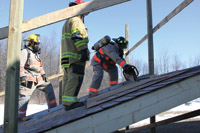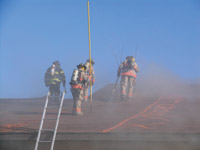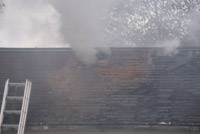
Features
Structural
Training
Back to Basics: March 2011
In February, we focused on ventilating a structure by removing the windows. Most fire departments use this method of ventilation. Vertical ventilation is another common type of ventilation but its popularity is waning because of the risks it poses to firefighters.
March 1, 2011
By Mark van der Feyst
In February, we focused on ventilating a structure by removing the windows. Most fire departments use this method of ventilation. Vertical ventilation is another common type of ventilation but its popularity is waning because of the risks it poses to firefighters.
 |
||
| Working on a roof ladder to make a cut can be awkward, and overreaching makes the job even more difficult. Here, a firefighter starts to make the initial cut and his arms are fully extended. It’s OK to step off the roof ladder to make cuts. |
||
 |
||
| The span of the roof is too long for a roof ladder so firefighters must rely on the size-up, the sounding of the roof and reports from the interior crews about how the fire is progressing to ensure it is safe to be on the roof. | ||
 |
||
| Cutting a hole in the roof is the best way to achieve ventilation quickly. Photos by Mark van der Feyst |
Vertical ventilation is a quick way to remove hot gases and smoke from the upper portions of a structure. Because heat rises naturally, all the smoke and hot gases will travel to the highest point in the structure. Allowing the smoke and hot gases to escape through a vertical opening results in better visibility for firefighters and a lower temperature inside the structure. Vertical ventilation also prevents horizontal fire spread and helps to clear smoke from public hallways and stairways.
But vertical ventilation is dangerous. In some cases, firefighters have fallen through the roof while trying to ventilate and now the fire service is reconsidering the need to be on top of the structure. There are many videos available that show tests being conducted on different types of roof materials and the time it takes for a roof to fail under load. The City of Phoenix Fire Department, along with the National Institute for Occupational Safety and Health, conducted some of these tests using two test mannequins standing on the roof of a structure on fire. It did not take long for the roof to fail and for the test mannequins to fall through. The time varied depending on the type of roof materials being tested. A YouTube search will yield several videos demonstrating the quick failure rate of lightweight trusses.
Roofing materials used today are designed to be lightweight and to span greater distances. While this lightweight technology provides advantages for builders, it is a great disadvantage to the fire service because the lightweight material fails much more quickly than traditional materials. A common time frame established for failure of a lightweight truss is between five and 15 minutes under fire conditions. This is not much time for fire departments to cut a hole for vertical ventilation.
Using existing openings found on rooftops is a benefit to any vertical ventilation operation and aids in quick ventilation. Skylights, scuttle hatches, HVAC equipment, stairway doors that exit to the roof and vertical vent pipes are some common openings found on rooftops. All these items are a good starting point for opening up the building to remove smoke and hot gas.
Cutting a hole in the roof is the best way to quickly achieve ventilation. Sometimes a series of holes is needed to ventilate effectively. Before firefighters head to the roof to cut a hole, a few things must be considered:
- Where is the fire located?
- We want to cut the hole directly above the fire.
- How big is the fire?
- We may need to cut more than one hole.
- What operations are underway and where are they located?
- We do not want to interfere with any interior or exterior operations.
- Is the fire already breaching the roof?
- If we see flames breaching through the roof, the roof will not support the weight of a firefighter or firefighters and will fail.
A combination of hand tools and power tools is generally used to cut a vertical opening. Hand tools include an axe – both pick head and flat head – a Halligan, pike pole, roof hook, sledge-hammer and others such as the TNT five-in-one tool. Rotary saws or chainsaws are generally the power tools of choice; both are gasoline-powered and require clean air to operate, as the clean air mixes with the fuel for internal combustion. One drawback with power tools is that they will not work properly and will sometimes stall if there is too much smoke exiting the structure. It is a good idea to bring both hand tools and a power tool up to the roof; the hand tools will serve as a backup to the power tools.
Another item to consider is the roof ladder. The roof ladder is designed to dissipate the weight of a firefighter along the roof. A roof ladder will only work if the top portion with the hooks is at the top of the roof ridge and the butt end of the ladder is hanging over the edge of the eaves of the roof. These two points of contact ensure the roof ladder is supported on the most structurally sound portions of the roof. If a roof ladder is shorter than the roof span, it will not be as effective as there will be no structural support. A roof ladder is not always required for conducting vertical ventilation. It will depend upon the conditions presented and the type of roof.
Working on a roof ladder to make the cut can be difficult and awkward. Overreaching to make cuts makes the job much more difficult. In photo 1, a firefighter is starting to make the initial cut and his arms are fully extended. There is nothing wrong with stepping off the roof ladder to make your cuts. Sound the roof with a hand tool or with your foot – if it sounds structurally strong, step off the roof ladder. If the roof is not safe, then you should not be up there anyway.
When making multiple holes in the roof, moving the roof ladder into position every time, from one spot to the next, may not be convenient. In photo 2, the span of the roof is too long for a roof ladder to be used. Here, the firefighters need to rely on the size-up of the conditions, the sounding of the roof and reports from the interior crews about how the fire is progressing to ensure that it is safe to be there.
Next time, we will look at different cuts and some tips on how to conduct vertical ventilation more easily using some common hand tools.
Mark van der Feyst is a 12-year veteran of the fire service. He currently works for the City of Woodstock Fire Department in Ontario. Mark is an international instructor teaching in Canada, the United States and India. He is a local level suppression instructor for the Pennsylvania State Fire Academy, an instructor for the Justice Institute of British Columbia and a professor of fire science at Lambton College. E-mail him at Mark@FireStarTraining.com
Print this page